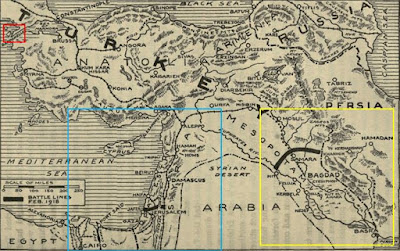 |
| The attack had to grind seven miles east- wards from the salient to Passchendaele |
The two most infamous
British battles of WW1 were undoubtedly the Somme and the third
Battle of Ypres, better known as Passchendaele. They were fought out one year
apart. Both lasted from July until November; both are filled with harrowing
memories and misery and are viewed as tragic attritional campaigns. In one
respect they were completely different. The first day of the Somme was a
disaster - the worst single day in the history of the British army. The first
day of Ypres 3 was, by the standards of the Western Front, a tactical triumph.
From the high (literal
and metaphorical) of the Messines assault in June (see Post 6/6/2017) seven long weeks
were to pass before the launch of the next stage of Haig’s grand plan. Surely, with
the disarray amongst the German command resulting from that cataclysm they
would be vulnerable to a breakthrough on their positions to the north of the
Menin Road before they had time to reorganise? In retrospect the delay seems
unaccountable, and unforgiveable.
However there were
three main reasons. Firstly, there was the logistical issue of providing
sufficient supplies, men and reserves for another major campaign. One of Haig’s
main justifications for his plan was the parlous state of the French army after
Nivelle’s offensive. He had to negotiate with Petain for French occupation of
the Arras area, in order to bring more of his own troops north from France. Along with
the very practical issues of moving and supplying these troops in war torn
country, the discussions with the French took time and they, ironically, did
not want to be left out of the battle completely. Secondly, the German defences were not in
complete disarray – in fact they had long prepared the muddy terrain involved
with redoubts and pill boxes, many of them hidden. Haig wanted some time for air
reconnaissance and raids to inform his preparations. Thirdly, and most
tellingly were the strategic and political aspects. Lloyd George and most of
his government were highly sceptical of Haig’s proposals. They wanted to avoid
another Somme; felt that even with the capture of Passchendaele Haig had little
chance of moving beyond, through Klerken to the coast; and were getting advice
that even the capture of Zeebrugge and Ostend would not necessarily blunt the
effectiveness of Germany’s U-boat campaign (Haig’s other main argument). With
the CIGS (Sir William Robertson) as his only strong ally in Government, Haig
had to wait until mid July before gaining grudging permission to go ahead from
Lloyd George, who was far more interested in a switch of emphasis to the
Italian Front.
With the Germans
re-doubling their defensive preparations – and adding new troops from the
Russian front all the time - Ypres 3 became another race against time that was
lost conclusively by the British.
The front for this
battle was an 8 miles portion of the salient stretching from the northern limit
of the Messines offensive near Bellewaerde. At it’s northern end was Boesinghe, and Anthoine’s French 1st Army would take up this flank. The land in between
was a gradual climb of battle scarred earth, rising through a series of small
ridges to the highest ridge of Passchendaele and its village, seven miles to
the east. To make the best of summer conditions (sic) Haig needed to reach
Passchendaele within two weeks, before moving onwards north east to the coast.
Most of this ground was already a mass of mud, and so the Germans built their
redoubts and pill boxes rather than attempt to entrench themselves. Their new
flexible style of defence was to concede first lines early and then counter
attack from these redoubts. Each pill box contained 20-40 men and bristled with
machine guns. Buchan describes the defences as “highly elastic rather than
the cast iron of the Siegfried line”.
Only the British 3rd
Army remained in France (now under Byng, since Allenby had been sent to Cairo –
see previous post). The redistribution of forces left Gough’s 5th
Army with the main responsibility for the battle. With Anthoine on his left
flank and elements on Plumer’s victorious 2nd army on his right. Rawlinson’s 4th
Army wheeled round to the north of Anthoine, replacing the small Belgian army there,
and planning for the breakthrough to the coast. Plumer’s orders were to push
south eastwards towards Lille from Hollebeke to draw off German artillery from
the main thrust.
 |
| Hubert de la Poer Gough. Frustrated by commanding the reserve at the Somme, he was centre stage this time |
Most significantly the
rain – the legendary rain of the third battle of Ypres – had started during the
afternoon. A great low pressure system originating in the mid-Atlantic had
swept up the Channel and arrived in Belgium, where it proceeded to dump its
contents. In her superb book ‘They called it Passchendaele’, Lyn Macdonald
gives this graphic description of the the rain that created a quagmire in which
men, horses, supplies and ammunition sunk without trace; and that turned the
tiny Sonnebeek stream (a first day objective) into an impassable torrent: “It went on raining as if some malevolent
deity had opened a tap in the heavens. It rained in sheets, in torrents, in
cataracts. It rained as no man since Noah had remembered it raining before. It rained
without stopping for four days and four nights.” It would be a further two weeks
before the 5th Army could resume its mission before Passchendaele. Whatever
may be said about Haig, it cannot be said he was lucky with the weather.






